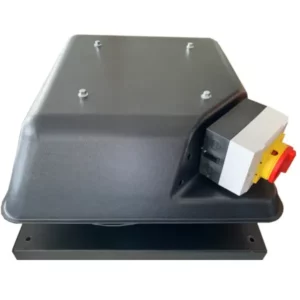Axial roof fans play a crucial role in maintaining proper ventilation and climate control in various settings. These fans are specifically designed for installation on rooftops, offering efficient air movement and extraction capabilities. In this article, we will explore the role and benefits of axial roof fans, highlighting their importance in promoting airflow, improving indoor air quality, and ensuring comfortable environments.
Here’s some of the importance of Axial roof fans in promoting airflow:
I. Importance of Ventilation:
- Air Quality Enhancement: Adequate ventilation is essential for maintaining good indoor air quality. Axial roof fans facilitate the exchange of stale or polluted air with fresh outdoor air, reducing the concentration of contaminants, odors, and moisture. This promotes a healthier and more comfortable environment for occupants.
- Moisture and Humidity Control: Excessive moisture and humidity can lead to mold growth, structural damage, and discomfort. Axial roof fans help remove excess moisture, preventing the buildup of condensation and reducing the risk of mold and mildew. This is particularly important in areas such as bathrooms, kitchens, and industrial spaces.
II. Role of Axial Roof Fans:
- Efficient Air Movement: Axial roof fans are designed to move large volumes of air effectively. They draw air from the space below and expel it outside, creating a continuous flow of fresh air. This helps regulate temperature, remove airborne contaminants, and prevent stagnant air pockets.
- Heat Dissipation: In industrial and commercial settings, equipment and processes can generate significant heat. Axial roof fans aid in dissipating heat by extracting hot air and allowing cooler air to replace it. This helps maintain optimal operating temperatures, prolongs equipment lifespan, and ensures worker comfort.
III. Benefits of Axial Roof Fans:
- Energy Efficiency: Axial roof fans are engineered for high efficiency, consuming less power while delivering effective air movement. This results in energy savings and reduced operational costs, making them a sustainable choice for ventilation and climate control.
- Space Optimization: Roof-mounted installation allows axial fans to utilize vertical space efficiently. This is particularly advantageous in areas with limited floor space, as it eliminates the need for bulky ventilation equipment within the occupied area, maximizing usable space.
- Low Noise Levels: Axial roof fans are designed to operate quietly, minimizing noise disruptions in residential, commercial, or office settings. Their low noise levels contribute to a peaceful environment, making them suitable for applications where noise reduction is critical.
- Easy Installation and Maintenance: Axial roof fans are designed for straightforward installation on rooftops, making them accessible and convenient for ventilation system setups. Additionally, their simple construction and fewer moving parts result in reduced maintenance requirements and lower associated costs.
Axial roof fans play a vital role in promoting ventilation, air quality, and climate control. Their efficient air movement capabilities, heat dissipation properties, and energy efficiency make them indispensable in various environments ranging from residential buildings to industrial facilities. By utilizing axial roof fans, businesses and homeowners can create healthier, more comfortable spaces while optimizing energy usage and enhancing overall indoor air quality.
Here is more information about axial flow roof fans:
How it works:
Axial flow roof fans push the flow of air through the rotation of axial flow blades. They are usually installed on the roof of a building and can be used to vent indoor air to the outside through air ducts, or to bring fresh outside air inside. This design allows axial flow roof fans to efficiently deliver large amounts of air flow, suitable for locations requiring extensive ventilation.
Application field:
Axial flow roof fans play an important role in a number of areas:
- Commercial buildings: Axial flow roof fans are used in ventilation systems in commercial buildings, including shopping malls, office buildings, hotels and restaurants. They help get rid of smoke, odors, and moisture, keeping the air in your room fresh and comfortable.
- Industrial facilities: Factories, warehouses and production facilities often require the removal of large amounts of heat and exhaust gases. Axial flow roof fans can efficiently discharge hot air and harmful gases, ensuring a safe and comfortable working environment.
- In the agricultural sector: In greenhouses and fields, axial flow roof fans help regulate temperature, humidity and air flow to promote plant growth and health.
- Multiple sizes and configurations:
- Axial flow roof fans are available in different sizes and configurations according to specific requirements. This makes them suitable for a variety of sites and installation requirements, whether small commercial buildings or large industrial facilities.
Waterproof and weather resistance:
Because axial flow roof fans are exposed to outdoor environments, they are often designed with water and weather resistance in mind. They are made of high quality materials and are sealed to prevent moisture and weather conditions from damaging them.
Control systems and Automation:
Many axial flow roof fans are equipped with advanced control systems that can be integrated with the building’s automation systems. This makes the fan start and stop, speed adjustment and timing operation more convenient and flexible.
Security considerations:
Axial flow roof fans are usually designed with safety in mind. They have a protective net or cover to prevent outside objects from entering, as well as safety measures to prevent accidental contact with the rotating blades.
To sum up, axial flow roof fans play an important role in promoting ventilation, improving indoor air quality and controlling the climate. Their efficient air flow, weatherability and reliability make them an indispensable component in commercial buildings, industrial facilities and agriculture. Through the proper installation and use of axial flow roof fans, we can create a healthier and more comfortable indoor environment, increase energy efficiency, and improve overall indoor air quality.
